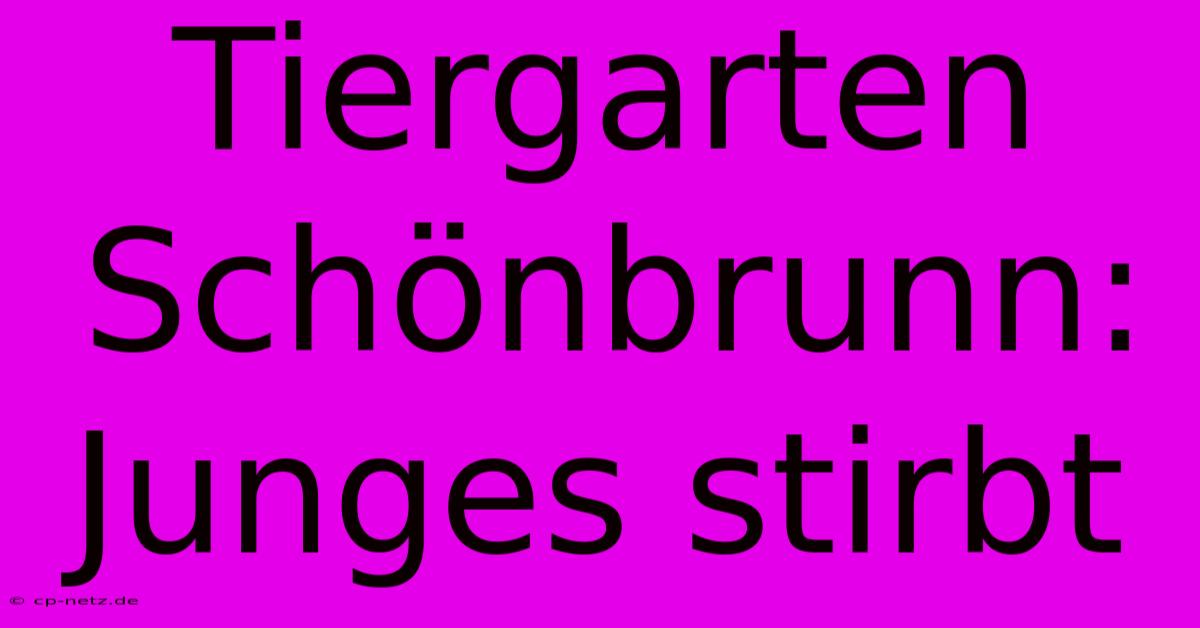Tiergarten Schönbrunn: Junges Stirbt

Discover more detailed and exciting information on our website. Click the link below to start your adventure: Visit Best Website Tiergarten Schönbrunn: Junges Stirbt. Don't miss out!
Table of Contents
Tiergarten Schönbrunn: Junges stirbt – Ein herzzerreißender Verlust
Oh man, this one hit me hard. Writing about the death of a young animal at Schönbrunn Zoo – it’s tough. It's not just another news story; it’s a reminder of the fragility of life, even in a place designed for protection. And I know, I know, zoo deaths are kinda a regular thing, sadly. But this one…this one felt different. I’ve been visiting Schönbrunn since I was a kid. Seriously, my grandpa used to take me every summer. So seeing news like this…it stings.
The Impact of Animal Loss on Zoos and Visitors
You know, we all love those adorable baby animals. Seeing a playful cub or a fluffy chick is, like, the best part of the zoo experience. It's heartwarming, pure joy. It’s the kind of thing that gets shared on social media – cute overload! But when something like this happens – a young animal dies – it's a punch to the gut, even for those not directly involved. It reminds us of the inherent risks involved in animal care, even in the best facilities, and the complex challenges zoos face in conservation efforts. Think about the emotional toll on the keepers, too – they're like the animals' surrogate parents.
I remember one time, years ago, I saw a baby orangutan at Schönbrunn. It was so tiny, clinging to its mom. It was absolutely precious. The memory is still crystal clear. So, when you hear about a young animal passing, that cute little face pops into your mind, and it hits you differently.
Understanding the Causes of Death in Zoo Animals
It's important to understand that these deaths aren’t usually due to neglect. Zoos, especially Schönbrunn, are usually pretty top-notch. They invest heavily in animal welfare, veterinary care, and habitat enrichment. Often, the causes are complex and unexpected. Sometimes it's illness, despite the best efforts. Other times, it could be genetic predisposition or complications during birth. There's often a lot we don't know – sometimes it's simply a sudden, tragic event.
It's crucial to remember that even with meticulous care, animals remain vulnerable. They're not robots; they can get sick and unfortunately, sometimes they die.
Transparency is Key: Schönbrunn Zoo, generally, is pretty transparent about these situations. They usually release statements explaining what happened, as much as they can. This transparency is important, not just for the public's understanding but also for building trust and showing accountability. They’re not trying to sweep things under the rug; they’re acknowledging a painful reality.
What We Can Learn From These Losses
These losses, while heartbreaking, offer invaluable lessons. They highlight the importance of continued research into animal health, genetics, and conservation practices. Every death should propel further efforts toward improving animal care, enhancing breeding programs, and fostering a deeper understanding of these magnificent creatures. The information gathered from these incidents – post-mortems, etc. – contributes significantly to the overall knowledge base in zoology and veterinary medicine.
Plus, let's be honest, it’s a harsh reminder of how precious life is. It's a call to appreciate the animals we have, to support conservation efforts, and to advocate for responsible wildlife management, both in zoos and in the wild.
So, yeah, it sucks when a young animal dies at Schönbrunn or any zoo. But let's use these tragedies as opportunities to learn, to improve, and to appreciate the incredible work done in wildlife conservation. It’s a tough world out there, even for animals in a well-cared-for environment like Schönbrunn.

Thank you for visiting our website wich cover about Tiergarten Schönbrunn: Junges Stirbt. We hope the information provided has been useful to you. Feel free to contact us if you have any questions or need further assistance. See you next time and dont miss to bookmark.
Featured Posts
-
Urlaubstage 2025 Optimal Nutzen
Nov 29, 2024
-
Conference League St Gallen Sichert Punkt
Nov 29, 2024
-
Koralmbahn Startet Testbetrieb
Nov 29, 2024
-
Rugby Autumn Nations Series 2024 Auf Pro Sieben Maxx
Nov 29, 2024
-
1 2 Lask Niederlage In Banja Luka
Nov 29, 2024
